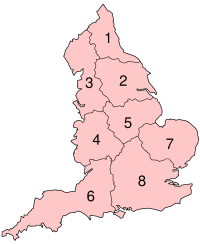East Anglia
East Anglia is a geographical and cultural region in the east of England, comprising the counties of Norfolk, Suffolk, and Cambridgeshire. The region has a rich history dating back to the pre-Roman era and was once the kingdom of the East Angles, a tribe that settled in the area during the 5th and 6th centuries. East Anglia is known for its distinctive landscapes, including the Norfolk Broads, a network of rivers and lakes, and the Fenlands, an area of reclaimed marshland. It also boasts a number of historic towns and cities, such as Norwich, the region's administrative and historical capital, known for its medieval cathedral and castle.
History[edit | edit source]
East Anglia's history is marked by its establishment as the kingdom of the East Angles during the Anglo-Saxon period. The region played a significant role in the history of England, including during the Viking invasions when it was a part of the Danelaw. In the medieval period, East Anglia became prosperous due to the wool trade, leading to the construction of impressive churches and buildings, many of which still stand today.
Geography[edit | edit source]
The geography of East Anglia is characterized by its flat, low-lying landscapes, particularly in the Fenlands, which have been drained over centuries for agriculture. The Norfolk and Suffolk coasts offer a mix of sandy beaches, cliffs, and estuaries, making the region popular for tourism. The Norfolk Broads, a series of rivers and lakes, is a significant feature of the region, offering boating, fishing, and wildlife watching opportunities.
Economy[edit | edit source]
The economy of East Anglia is diverse, with a strong emphasis on agriculture, particularly in the fertile Fenlands. The region is also known for its energy sector, particularly renewable energy from wind farms off the coast and the Sizewell nuclear power station in Suffolk. Tourism is another significant contributor to the economy, with visitors attracted to the region's natural beauty, historic towns and cities, and cultural festivals.
Culture[edit | edit source]
East Anglia has a rich cultural heritage, with traditions such as the Norwich School of painters, the first provincial art movement in England. The region's literature is also notable, with authors such as George Orwell and Kazuo Ishiguro having strong connections to the area. East Anglia's folk traditions, including music, dance, and folklore, are celebrated in festivals throughout the year.
Education[edit | edit source]
The region is home to several institutions of higher education, including the University of East Anglia (UEA) in Norwich, known for its creative writing program, and Anglia Ruskin University with campuses in Cambridge and Chelmsford. These institutions contribute to the region's vibrant cultural scene and support research and innovation in various fields.
Transport[edit | edit source]
East Anglia is served by a network of roads and railways, providing connections to London and the rest of the UK. The main railway line from London Liverpool Street serves major towns and cities in the region, including Norwich, Ipswich, and Cambridge. The region's relatively flat terrain makes it popular for cycling.
Conclusion[edit | edit source]
East Anglia is a region with a unique identity, shaped by its history, geography, and culture. It offers a blend of historic sites, natural beauty, and modern innovation, making it an important and distinctive part of England.
Navigation: Wellness - Encyclopedia - Health topics - Disease Index - Drugs - World Directory - Gray's Anatomy - Keto diet - Recipes
Search WikiMD
Ad.Tired of being Overweight? Try W8MD's physician weight loss program.
Semaglutide (Ozempic / Wegovy and Tirzepatide (Mounjaro / Zepbound) available.
Advertise on WikiMD
WikiMD is not a substitute for professional medical advice. See full disclaimer.
Credits:Most images are courtesy of Wikimedia commons, and templates Wikipedia, licensed under CC BY SA or similar.Contributors: Prab R. Tumpati, MD





